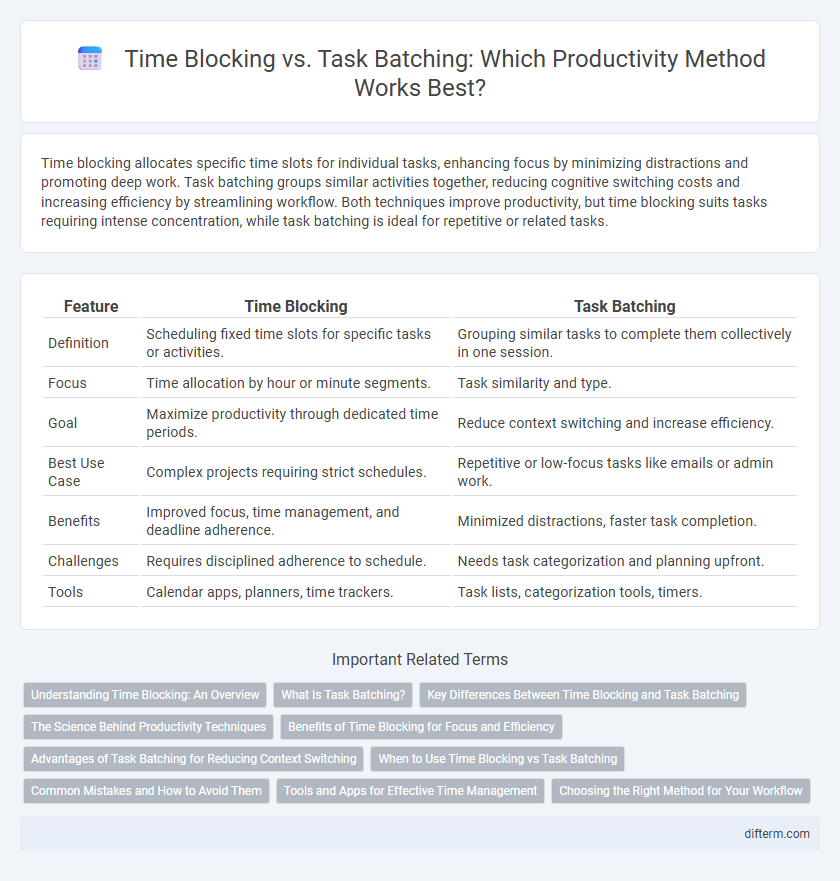Time blocking allocates specific time slots for individual tasks, enhancing focus by minimizing distractions and promoting deep work. Task batching groups similar activities together, reducing cognitive switching costs and increasing efficiency by streamlining workflow. Both techniques improve productivity, but time blocking suits tasks requiring intense concentration, while task batching is ideal for repetitive or related tasks.
Table of Comparison
| Feature | Time Blocking | Task Batching |
|---|---|---|
| Definition | Scheduling fixed time slots for specific tasks or activities. | Grouping similar tasks to complete them collectively in one session. |
| Focus | Time allocation by hour or minute segments. | Task similarity and type. |
| Goal | Maximize productivity through dedicated time periods. | Reduce context switching and increase efficiency. |
| Best Use Case | Complex projects requiring strict schedules. | Repetitive or low-focus tasks like emails or admin work. |
| Benefits | Improved focus, time management, and deadline adherence. | Minimized distractions, faster task completion. |
| Challenges | Requires disciplined adherence to schedule. | Needs task categorization and planning upfront. |
| Tools | Calendar apps, planners, time trackers. | Task lists, categorization tools, timers. |
Understanding Time Blocking: An Overview
Time blocking involves allocating specific time periods on a calendar to individual tasks or activities, enhancing focus and reducing distractions for improved productivity. This method creates structured work intervals, enabling better time management by limiting multitasking and helping prioritize important tasks. By visually segmenting the day, time blocking fosters discipline and encourages consistent work habits, making it a valuable strategy for optimizing workflow efficiency.
What Is Task Batching?
Task batching is a productivity technique that involves grouping similar tasks together to complete them in a dedicated time period, minimizing context switching and enhancing focus. This method allows individuals to streamline workflows by reducing distractions and increasing efficiency when handling repetitive or related activities. Task batching is especially effective for routine tasks such as email management, data entry, or administrative work, leading to improved time management and overall productivity.
Key Differences Between Time Blocking and Task Batching
Time blocking allocates specific time periods for individual tasks on a calendar, enhancing focus on one task at a time, while task batching groups similar tasks together to be completed consecutively, minimizing context switching. Time blocking offers a structured daily schedule with set start and end times for activities, whereas task batching emphasizes efficiency by reducing the cognitive load associated with switching between different types of work. Key differences include time blocking's calendar-based approach versus task batching's thematic grouping of tasks to improve workflow and reduce distractions.
The Science Behind Productivity Techniques
Time blocking enhances productivity by allocating specific hours to individual tasks, promoting deep focus and reducing decision fatigue. Task batching groups similar tasks to minimize cognitive switching costs, leveraging the brain's pattern recognition for efficiency. Neuroscientific studies reveal that structured work periods activate the prefrontal cortex, improving attention control and task execution speed.
Benefits of Time Blocking for Focus and Efficiency
Time blocking enhances focus by allocating specific periods for individual tasks, reducing distractions and multitasking. This method boosts efficiency through clear boundaries that promote deep work and better time management. Consistent use of time blocking leads to improved task completion rates and a more structured daily routine.
Advantages of Task Batching for Reducing Context Switching
Task batching significantly reduces context switching by grouping similar tasks together, allowing the brain to maintain focus and streamline workflows. This method minimizes cognitive load and decreases the time lost during transitions between different types of activities. By concentrating on related tasks, productivity naturally improves and mental fatigue lessens, enhancing overall efficiency.
When to Use Time Blocking vs Task Batching
Time blocking is ideal for tasks requiring focused, uninterrupted work during specific hours, such as deep work or strategic planning, while task batching suits repetitive or similar activities like email processing or administrative duties. Use time blocking to allocate dedicated slots for high-priority projects demanding concentration, whereas task batching maximizes efficiency by grouping routine tasks to minimize context switching. Balancing both methods based on task complexity and urgency enhances overall productivity and time management.
Common Mistakes and How to Avoid Them
Time blocking often fails when schedules are too rigid, causing stress and missed deadlines, while task batching loses efficiency if tasks are too diverse, leading to frequent context switching; to avoid these mistakes, allocate flexible time slots in your calendar and group similar tasks that require comparable cognitive resources. Avoid underestimating transition time between batches, which disrupts flow and productivity, by including buffer periods to reset mentally. Regularly reviewing and adjusting your blocks or batches based on real performance data ensures sustainable productivity and minimizes burnout.
Tools and Apps for Effective Time Management
Time blocking and task batching significantly enhance productivity through specialized tools like Google Calendar and Todoist, which facilitate precise scheduling and task grouping. Apps such as Trello and Asana offer seamless project visualization and collaboration, supporting both time allocation and task categorization for efficient workflow management. Leveraging these tools maximizes focus, reduces context switching, and optimizes daily time utilization.
Choosing the Right Method for Your Workflow
Time blocking enhances productivity by allocating specific time slots for individual tasks, ensuring focused attention and reducing context switching. Task batching groups similar activities together, maximizing efficiency by minimizing transition time between different types of work. Selecting the right method depends on your workflow's nature; use time blocking for tasks requiring deep concentration and task batching for repetitive or similar tasks to optimize overall output.
Time blocking vs Task batching Infographic

 difterm.com
difterm.com